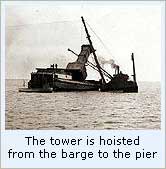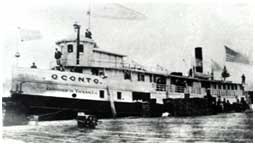A Brief History of Charity Island
 Charity Island is actually an outcropping of limestone that was formed 350 million years ago when most of North America and all of Michigan was covered by a warm shallow ocean. That ocean was full of primitive minute sea creatures that took calcite from the sea water to construct their shells. As they died their shells were deposited on the ocean floor and ultimately formed into the “Bayport Limestone” formation..
Charity Island is actually an outcropping of limestone that was formed 350 million years ago when most of North America and all of Michigan was covered by a warm shallow ocean. That ocean was full of primitive minute sea creatures that took calcite from the sea water to construct their shells. As they died their shells were deposited on the ocean floor and ultimately formed into the “Bayport Limestone” formation..



The limestone that outcrops along the Island’s shoreline is heavily embedded with the mineral “chert”, a low grade from of flint. Over time the island became an important source of chert for stone tool making by native American Indians who occupied the island for nearly 2,000 years before the first Europeans arrived.

 For a period of time the Sauks occupied the Saginaw Bay Area and controlled access to the Flint deposits until the Chippewas & other tribes fought and annihilated the Sauks in 1535 near Pt. Au Gres, Michigan. Ultimately, the entire Sauk Nation was driven from Michigan and today are in Oklahoma.
For a period of time the Sauks occupied the Saginaw Bay Area and controlled access to the Flint deposits until the Chippewas & other tribes fought and annihilated the Sauks in 1535 near Pt. Au Gres, Michigan. Ultimately, the entire Sauk Nation was driven from Michigan and today are in Oklahoma.
The Island was visited by La Salle in August of 1679 arriving on the first sailing vessel on Lake Huron, Le Griffon. He found the natives living on the island were growing squash, beans, and corn.
Charity island was included in property ceded to the British by the French in the Paris Treaty of 1763. Finally, this Territory became property of USA in 1805.
Michigan became a State in 1837 and Charity Island became part of the state of Michigan.

 Charity Island played an important role in early Great Lakes shipping when a Lighthouse was built on the northern most point of the island in 1857. The Island was formally acquired by the federal government with an executive order signed by Abraham Lincoln fifteen days before he was assassinated.
Charity Island played an important role in early Great Lakes shipping when a Lighthouse was built on the northern most point of the island in 1857. The Island was formally acquired by the federal government with an executive order signed by Abraham Lincoln fifteen days before he was assassinated.
Oconto 1885
At age 18 Wm. L. Pierce is assigned the position of Ass’t Lightkeeper on Charity Island in 1885. He plays an important role in the dramatic rescue of passengers when the wooden steamboat Oconto flounders off Charity Island in a December Gale.

 In 1917 Charity island becomes one of the first Lighthouses on the Great Lakes to become automated due to the remarkable achieve- ments of the renown Swedish inventor, Nils Gustav Dalen.
In 1917 Charity island becomes one of the first Lighthouses on the Great Lakes to become automated due to the remarkable achieve- ments of the renown Swedish inventor, Nils Gustav Dalen.
 After devising a method of safely storing acetylene gas in metal containers Dalen invents an ingenious gas valve capable of igniting the towers light under cloud cover, fog and at nightfall, and extinguishing the light at sunrise.
After devising a method of safely storing acetylene gas in metal containers Dalen invents an ingenious gas valve capable of igniting the towers light under cloud cover, fog and at nightfall, and extinguishing the light at sunrise.

Soon his inventions are providing light for mariners all around the world and earns him the Nobel Prize in 1912 and the contract to light the Panama Canal in 1914.
Ironically, after inventing a reliable light source for thousands of mariners around the world he is permanently blinded in a laboratory experiment in 1912.
Charity Island became an important base of operations for the “Gillingham Fish Co.”, (one of the largest on the Great Lakes) in the 1880’s.


After 72 years of service, the Charity Island light is finally abandoned when the Gravelly Shoals Lighthouse is completed an put in operation in 1939.
In 1992 the Island was purchased by Karen and Robert Wiltse who are committed to preserving the Charity Island light as an important remnant of Great Lakes maritime history and to seeing it developed as an important economic asset for Northeast Michigan as a tourist destination.


For more of the history and to experience our delicious Great Lakes crusine call us for group tour pricing and/or for help on an itinerary that will be sure to delight your customers.

